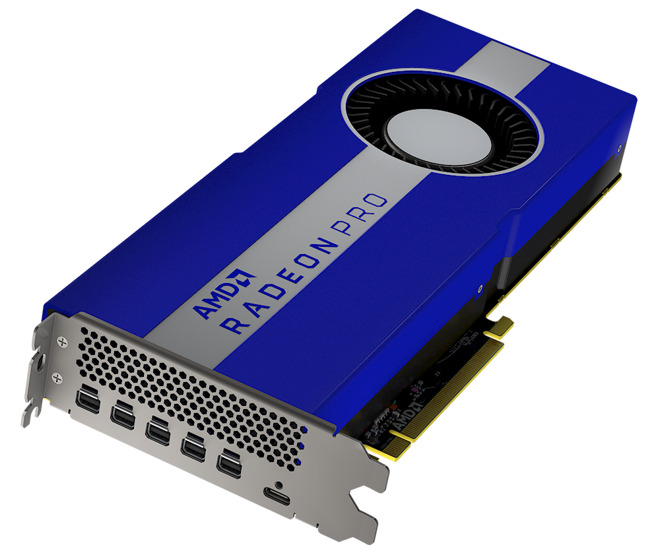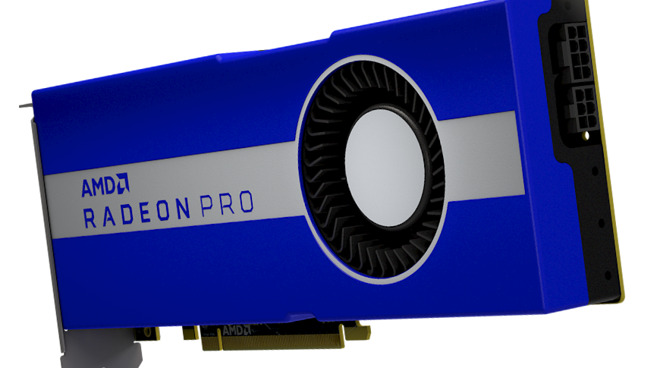AMD's $799 Radeon Pro W5700 offers a potential GPU alternative for the Mac Pro
AMD has updated its workstation graphics card lineup ahead of the launch of the new Mac Pro, with the Radeon Pro W5700 line using AMD's high-performance RDNA graphics architecture and offering up to six display outputs, including one over USB-C.
Launched on Tuesday, the Radeon Pro W5700 is declared as the world's first PC workstation graphics card that uses a 7-nanometer process to make the GPU. The professional counterpart to the consumer-aimed Radeon RX5700 from June, the W5700 continues the momentum of that graphics card launch, but for the professional market.
The Radeon Pro W5700 offers 36 compute units and 8GB of GGDR6 memory, the same as the consumer model, but the performance has been improved so it offers up to 8.89 teraflops at the top end, versus the 7.95 of the RX5700. The card also has 448 gigabytes per second of memory bandwidth, while the switch to the RDNA graphics architecture is said to offer a 25% better performance per compute unit than the previous GCN architecture, and a thermal design point of 205 Watts.
In terms of performance over the previous generation, AMD claims the new Radeon Pro W5700 offers up to 41% higher average performance per Watt over GCN, in comparisons against the Radeon Pro WX8200. Against its main rival, the Nvidia Quadro RTX 4000, the Radeon Pro is also claimed to be 18% more power efficient, both under load and at idle.
At the same time, the Radeon Pro is more powerful than the Quadro in benchmarks using professional software suites Solidworks, Catia, and Autodesk's Maya by between 4% and 7%. Under a frames-per-second comparison on synthetic benchmarks, the Radeon Pro comes out on top in the Unity VR "London Office" demo at 94fps to 92fps and the Enscape "Mansion" demo at 58fps to 55fps, but is just behind the Quadro RTX in the Unity Automotive Benchmark at 93fps to 92fps.
AMD makes the claim the W5700 is far better at handling multitasking performance, with a 5.6 times better application workflow performance in the SpecViewPerf 13 benchmark while under CPU load than the Quadro RTX 4000.
In terms of other notable elements the Radeon Pro W5700 has six display outputs, consisting of five mini DisplayPort connections alongside a single USB-C port, one which is capable of up to 15W of power delivery, with the card also offering up to an 8K resolution for video.
AMD intends to make the card more useful for its intended professional market by scheduling a main enterprise driver release on a quarterly basis. The reason is due to AMD performing enhanced stress testing of the drivers for 24-hour working environments, as well as extensive testing on multiple hardware vendor platforms to ensure it works as expected before release.

Part of the AMD Radeon Pro Software for the card is AMD Remote Workstation, which allows workers to remotely access the workstation with the installed card, such as from a notebook at home or on a business trip. The thinking of this is to enable access to the performance of the card for work while away from the office on a lower-powered computer, something AMD believes will be essential due to predictions 72% of the US workforce will be mobile by 2020.
The card will include support for wireless professional VR applications via Radeon ReLive for VR, including the HTC Vive Focus Plus, with support for VR product design tools and platforms such as Unreal Studio, Unity, and SolidWorks also promised.
The Radeon Pro W5700 is priced at $799, and is available from today, with users in the US able to acquire it from B&H Photo and Newegg.
The card is certainly one of interest for the intended customers of Apple's modular Mac Pro, which could be offered as an alternative to the Radeon Pro Vega II and Duo graphics cards that will be available for the workstation. Whereas the Vega II and Duo will be usable only in one of the Mac Pro's MPX Module bays, the W5700's use of PCIe 4 means it will work with any of the PCIe 3 slots in the case, as well as in eGPU enclosures for use with Macs, MacBooks, and other computer hardware.
Launched on Tuesday, the Radeon Pro W5700 is declared as the world's first PC workstation graphics card that uses a 7-nanometer process to make the GPU. The professional counterpart to the consumer-aimed Radeon RX5700 from June, the W5700 continues the momentum of that graphics card launch, but for the professional market.
The Radeon Pro W5700 offers 36 compute units and 8GB of GGDR6 memory, the same as the consumer model, but the performance has been improved so it offers up to 8.89 teraflops at the top end, versus the 7.95 of the RX5700. The card also has 448 gigabytes per second of memory bandwidth, while the switch to the RDNA graphics architecture is said to offer a 25% better performance per compute unit than the previous GCN architecture, and a thermal design point of 205 Watts.
In terms of performance over the previous generation, AMD claims the new Radeon Pro W5700 offers up to 41% higher average performance per Watt over GCN, in comparisons against the Radeon Pro WX8200. Against its main rival, the Nvidia Quadro RTX 4000, the Radeon Pro is also claimed to be 18% more power efficient, both under load and at idle.
At the same time, the Radeon Pro is more powerful than the Quadro in benchmarks using professional software suites Solidworks, Catia, and Autodesk's Maya by between 4% and 7%. Under a frames-per-second comparison on synthetic benchmarks, the Radeon Pro comes out on top in the Unity VR "London Office" demo at 94fps to 92fps and the Enscape "Mansion" demo at 58fps to 55fps, but is just behind the Quadro RTX in the Unity Automotive Benchmark at 93fps to 92fps.
AMD makes the claim the W5700 is far better at handling multitasking performance, with a 5.6 times better application workflow performance in the SpecViewPerf 13 benchmark while under CPU load than the Quadro RTX 4000.
In terms of other notable elements the Radeon Pro W5700 has six display outputs, consisting of five mini DisplayPort connections alongside a single USB-C port, one which is capable of up to 15W of power delivery, with the card also offering up to an 8K resolution for video.
AMD intends to make the card more useful for its intended professional market by scheduling a main enterprise driver release on a quarterly basis. The reason is due to AMD performing enhanced stress testing of the drivers for 24-hour working environments, as well as extensive testing on multiple hardware vendor platforms to ensure it works as expected before release.

Part of the AMD Radeon Pro Software for the card is AMD Remote Workstation, which allows workers to remotely access the workstation with the installed card, such as from a notebook at home or on a business trip. The thinking of this is to enable access to the performance of the card for work while away from the office on a lower-powered computer, something AMD believes will be essential due to predictions 72% of the US workforce will be mobile by 2020.
The card will include support for wireless professional VR applications via Radeon ReLive for VR, including the HTC Vive Focus Plus, with support for VR product design tools and platforms such as Unreal Studio, Unity, and SolidWorks also promised.
The Radeon Pro W5700 is priced at $799, and is available from today, with users in the US able to acquire it from B&H Photo and Newegg.
The card is certainly one of interest for the intended customers of Apple's modular Mac Pro, which could be offered as an alternative to the Radeon Pro Vega II and Duo graphics cards that will be available for the workstation. Whereas the Vega II and Duo will be usable only in one of the Mac Pro's MPX Module bays, the W5700's use of PCIe 4 means it will work with any of the PCIe 3 slots in the case, as well as in eGPU enclosures for use with Macs, MacBooks, and other computer hardware.



Comments
Technically it sounds feasible, but I can imagine it would add a huge amount to the cost of the card.
For instance the last of the cheesegrater Mac Pros (2012) came with cards that aren't Metal compatible. So if you added a PC (non-flashed) GPU, which was Metal compatible, then your Mac suddenly had an adrenaline boost in day to day usage. However if you then tried to install a newer macOS that as one of the system requirements required a Metal-compatible card, you can't: it runs the installer (once downloaded), reboots into the .dmg of the installer, finds no Metal compatible card with Mac firmware on it (to show you the installer wizard), bails, and boots back into whatever OS you came from beforehand. So in that particular situation, only a Metal compatible card that was either a "Mac" version (£££) or a PC version that had been flashed with Mac firmware, would get you to that later macOS.